#Vector Product Of Two Vectors
Explore tagged Tumblr posts
Photo

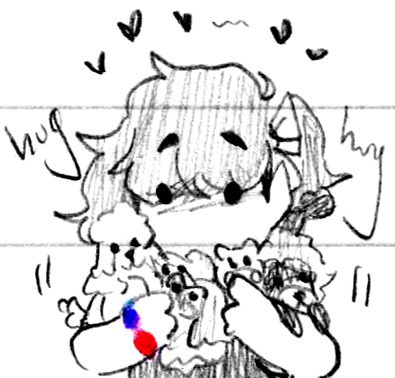



Webkinz collecting fever (Patreon)
#Doodles#Original#Tala#Webkinz#As previously mentioned - we ended up with a lot of Webkinz! 13 in total split between us 6-6-1-style (Ma also got one :3)#And I ended up with exactly what I wanted! Four new OG8s - puts me at over half total if I include Diamond!#Which I mean she gets half a point so that's Technically over half lol#/And/ I got my dearest Fluffy back - she was the first one I adopted back <3#We're planning on re-upping our Full memberships every ~6 months so there's a steady stream of 'kinz Excitement while not wasting them#And-and! Got a frog!! The temptation to call him something VUX-related is So incredibly strong you have no idea...#So all told I got a great group! I'm very pleased!#However. The impulsive little kid brain aspect. Y'know - Tala lol#It's been established for a while that Tala really likes Webkinz and seeing another seven whole Webkinz that are Not For Her#Oh kid brain lol#The things I'm most envious of are the Magic Ws honestly lol - two of smol's ended up with Pink Ws where all the rest are Yellows#As a bit of backstory - Webkinz production went through several passes including not having Any embroidered Magic Ws#Those being the oldest - the second oldests are the Pink Ws which start with a pink stripe from left to right#And then the final design is the Yellow which ended up being the standard going forward#They're very common for that reason! And harder to pin down an exact production time period#So seeing two Pink Ws that are not for me was hard lol - I still get to pat them if I want to! But Owning lol#It's all a very silly something but kid-and-fixation brain aren't always the most sensible creatures haha#I also wanted the one ma ended up with - the Elephant - because while it's not an OG8 it /is/ HM007#Just to keep things confusing lol ♪ But that's also part of why I wanted the frog so bad! HM001!! ♥#I'll get all of the first 20 at some point that's my current goal lol - and that's Including Googles because of the missing several!#And also the sketches for what would become the vector for smol :D Yay!
17 notes
·
View notes
Text
Remember, if your robotgirl is liquid cooled, you shouldn't refill her reservoir with plain water. You need the specific liquid coolant stuff because it's got chemicals to keep anything from growing in it. Just like the windshield washer on your car, you refill it with the specific product for it, not just plain water.
Why? Because robot girls and cars both run warm. You don't want a reservoir of water sitting around, or you get shit growing in it.
Ever hear of Legionnaires' disease? Legionella bacteria growing in the air conditioning system infected nearly two hundred people at a hotel during a convention. It was airborne, and 29 people died.
So yeah. Get the coolant liquid. Don't cheap out on water, or your robot girlfriend becomes a walking infection vector.
388 notes
·
View notes
Note
give me your post-viral wesker physical/bodily hcs please. what's he look like in there... do you have any pg67 function headcanons. the masses must know! (if you want to share, of course... i saw biology and i ran in here)
Okay so first of all congratulations, because with this question you accidentally triggered two of my fixations, resident evil lore and biology. So naturally I spent way too much time thinking about this at a molecular level, and emerged with a little manifesto on 'what the virus does to Wesker'.
Okay, lets get into it!
The virus inserts viral DNA directly into the host’s genome, permanently altering Wesker's genetic code. It targets specific stem cell populations to overwrite genetic instructions. These new genes code for synthetic proteins that give his body enhanced abilities. The virus functions similarly to an engineered gene therapy vector, but instead of fixing a mutation, it adds entirely new capabilities:
Healing Factor
• Wesker’s body heals stupidly fast. Bullet wounds seal up in real time. It’s not just fast, it’s efficient. No scar, no bruise, just gone. That’s because of proteins, that promote extreme tissue regeneration by accelerating transcription of growth factors.
• The viral DNA triggers production of proteins that upregulate mitochondrial efficiency. So his cells are constantly in overdrive, replicating and regenerating at insane speeds. That kind of process would literally melt a normal person from the inside out, but the virus keeps him juuuuust stable enough to survive it.
• That means he burns through nutrients and energy at an insane rate. But he still eats very little because his body has learned to metabolize efficiently.
• Because of this, he doesn’t get sick. Like, ever. No flu, no fever, nothing. His immune system probably nukes bacteria before they finish replicating.
Strength
• A key viral protein might mimic myostatin inhibitors, increasing muscle mass without bulk, think insane strength in a lean frame.
• He could punch a hole in reinforced steel if he wanted to, but the scary part is that he doesn’t. He holds back all the time. He can crack a man’s ribs with one hand, or gently zip up your jacket without pulling the tab off.
• His control is off the charts. He’s not just strong, he’s precise. Every movement is calculated.
Eyesight & Senses
• He sees more than most people. Infrared, low light, motion trails, his vision is layered. The world probably looks like a high-contrast heatmap half the time.
• That’s why he wears sunglasses 24/7. Not just for the aesthetic (though let’s be real, it’s working), but to help with light sensitivity. Without them, he’d probably get visual overload in a well-lit room. (Okay, Gojo Satoru)
• His hearing is sharp too. Not supernatural, but he can pick up your heartbeat if you're close enough. It makes sneaking up on him borderline impossible.
The PG67A/W Serum
• The serum is a lifeline. The virus is unstable on its own, the host cells try to over-replicate or misfire signals, leading to cellular death or mutation.
• PG67A/W likely acts as a suppressor or regulator, binding to specific viral receptors or feedback loops, controlling gene expression and inhibitory enzyme systems to keep certain proteins from overexpressing.
• He doses every 6 to 8 hours. He keeps spares on him at all times. If he’s on a mission, he builds his entire schedule around those injections.
• He hides injection sites on his inner thigh, shoulder, or hip, places easy to reach but not visible.
Body Temperature
• His body runs hot. Like, unnaturally warm to the touch, like 39°C on a normal day. You could probably use him as a space heater.
• He doesn’t sweat much, but if he’s pushing his limits, the heat builds up fast. He’ll disappear for a cold shower or just stand in front of an AC vent for five minutes without saying anything.
• Resting heart rate? Low. Like athlete-low, sometimes around 40 bpm. But if he moves into combat mode, it spikes instantly. Controlled tachycardia, probably tied to the virus.
Time Perception & Reflexes
• The virus likely alters neurotransmitter uptake and synaptic plasticity, enhancing reaction time and cognition. It increases dopamine and norepinephrine sensitivity, creating hyper-alertness without overstimulation.
• Neural conduction speed may be boosted by: enhanced myelination of neurons. Modified ion channels that allow faster action potential firing.
• The result? Time feels slower to him. His brain processes information so fast that everything else seems like it’s moving in slow motion. That’s why he reacts before you even finish blinking.
• But it’s also exhausting in a subtle way. Conversations feel slow. Meetings drag. He lives in a world that’s slightly out of sync.
Mutation Risk
• He’s constantly on the edge. The virus wants to take over, it wants him to evolve into something monstrous. He keeps that in check with raw willpower and serum, but it’s always there.
• He has nightmares about it. Not dying, mutating. Losing himself.
Aging
• The virus triggers production of novel proteins that tabilize telomeres.
• His aging basically stopped. He should be pushing 50, but he still looks like he’s in his late 30s at most.
Touch & Intimacy
• His body doesn’t regulate hormones quite the same anymore. He can feel arousal, desire, etc., but it’s slower to build and hits harder when it does.
• And his stamina...He doesn’t get tired, doesn’t lose focus, and has total control over his body. He can go for hours without so much as breaking a sweat, and he’s frustratingly composed the whole time
Pain Response
• The virus likely alters his nervous system, especially the nociceptors.
• Instead of fully shutting off pain, it modulates the intensity, filtering it through a “useful or not” lens.
• So he still feels pain, but it’s dulled. A knife wound feels like pressure. A gunshot is just an annoyance.
• He can weaponize it too. Take a hit, stay standing, stare you down without even flinching, smile on his face, it’s terrifying. And he knows it.
Anyway. That’s the gist of what I think is going on inside Wesker’s terrifyingly efficient, (incredibly attractive) body. Please note:
• I did have microbiology, but I’m studying environmental science.
• I am not a virologist or Umbrella scientist (tragic, I know), just someone who thinks too hard about fictional men with god complexes.
• Also, I had to use a translator for like 40% of the fancy terms because my English science vocab just noped out halfway through. So if something sounds too text book, blame the language barrier
Thank you for enabling me, lol
#resident evil#albert wesker#biology#biohazard#virology#albert wesker headcanons#resident evil headcanons#resident evil 5#umbrella corporation#bioweapon#uroboros
99 notes
·
View notes
Text

Was experimenting with halftone effects after watching this video and it almost has spiderverse vibes honestly. I actually learned some neat things about why printers use CMYK instead of just CMY so I thought I'd share !!
So in our optimal little computer space, Cyan (0,255,255), Magenta (255,0,255) and Yellow (255,255,0) all multiplied together gives us a perfect black (0,0,0) Awesome! The issue is that ink colors irl arent exactly perfect like this, and color is a bit more complicated irl compared to how computers represent it, so they aren't the greatest at combining into black if they aren't those perfect CMY values:
Left: CMY
Right: CMYK
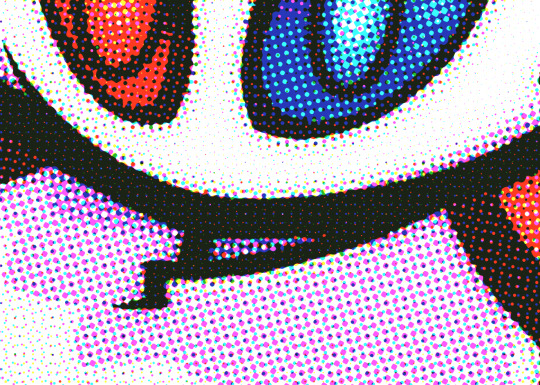

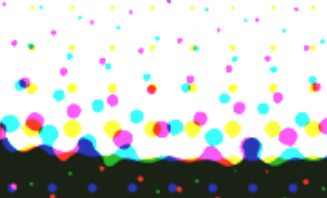
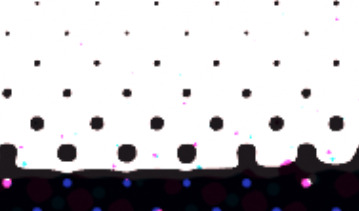
(thats not even black, its a dark blue in the original image but dark colors just look so much richer)
An important step to make sure you arent doubling up on the black values though is to divide the image by it's own "value" (the max of all 3 color channels) that way the value is equal to 1 everywhere, and you're letting the black ink take care of the value on its own.
Left: CMY (normalized value)
Middle: K (black)
Right: Combined

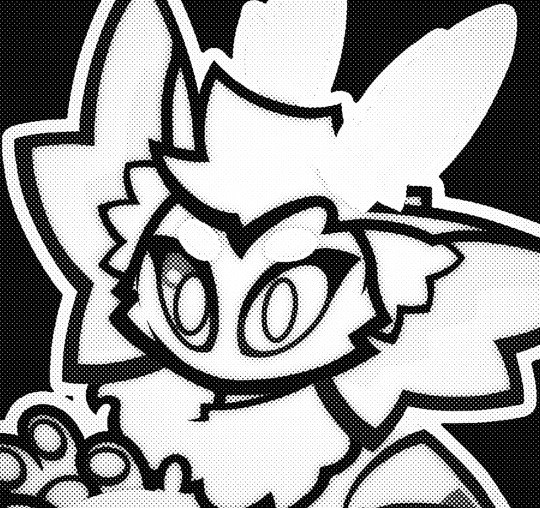

Now obviously the grids of dots cant be aligned perfectly with each other because you'd just get a bunch of black dots in unwanted areas, but if the grids are misaligned, then some dots become more prominent than others which tints the whole image. This was an issue because older printing methods didn't have great accuracy and these grids were often misaligned.
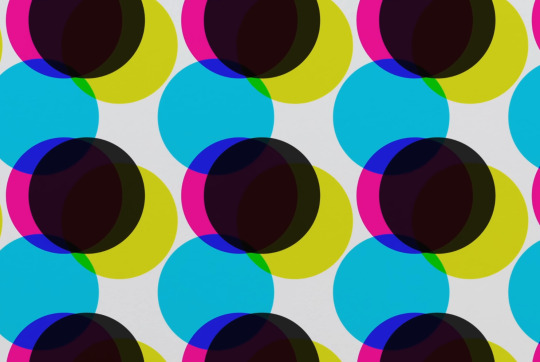
The solution was to rotate these grids such that they can move around freely while getting rid of that tint effect if they aren't perfectly aligned :D
(I have no idea how they came up with these angles but that might be something to look into in the future who knows)
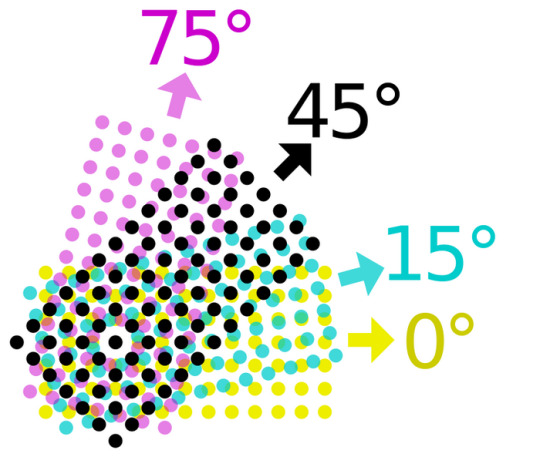
SPEAKING OF MISALIGNMENT
I wanted to implement that in my own filter to get some cool effects, and I discovered another reason CMYK is better than CMY for lots of stuff !!
With CMY, you're relying on the combination of 3 color channels to make the color black. This means if you have thin lines or just details in general, misalignment can make those details very fuzzy. Since CMYK uses a single color of ink to handle value, it reduces color fringing and improves clarity a lot even if you have the exact same misalignment as CMY!
Left: CMY
Right: You guessed it! CMYK



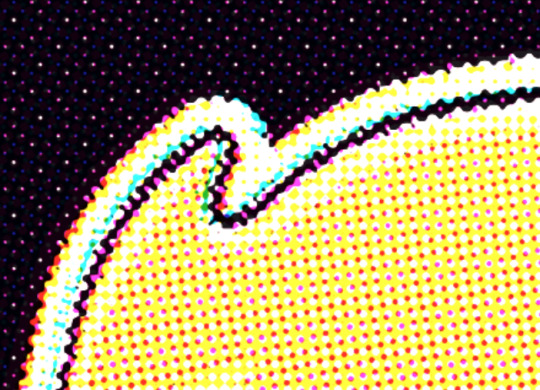


(yes these comparisons have the exact same color misalignment, the only difference is using a fourth ink color for black)
ANYWAY I just thought there was a lot of cool information in this tiny little day project, I also just think it looks really neat and wanted to share what I learned :3c



EDITING BECAUSE THERE'S ONE MORE THING I WANTED TO ADD
So, I talked about how to get K in addition to CMY instead of just CMY, but how exactly do you separate CMY from an image in the first place?
Well, CMY is a subtractive color space, meaning the "absence of color" is white, compared to RGB where it's black. This makes sense because ofc ink is printed on white paper. You can use dot product to get the "similarity" between two vectors, and this can be used to separate RGB actually! Using the dot product of a color and red (255,0,0) will give you just the red values of the image. This is cool though because if we get the dot product of our image and the color cyan (0,255,255), we can get the cyan values from our image too! If we first divide our colors by their value to separate the value from them, then separate CMY using those dot product values, and using K for our final black color value, our individual color passes end up looking like this:


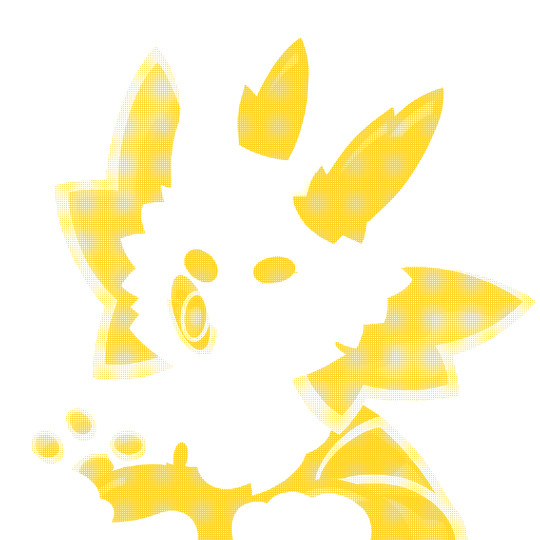

While it's called a "subtractive" color space, I find it more intuitive to treat white as the absence of color here, and then multiply all these passes together. It makes it much easier to understand how the colors are combined imo. Notice how cyan is the opposite of red: (255,0,0) vs (0,255,255) and magenta and yellow are the opposites of green and blue respectively! This means you can actually kinda get away with separating the RGB values and just inverting some stuff to optimize this, but this example is much more intuitive and readable so I won't go too deep into that. THANKS FOR READING I know it's a very long post but I hope people find it interesting! I try my best to explain things in a clear and concise way :3

oh thank you I realized I should probably add an eyestrain tag
1K notes
·
View notes
Note
what's the 3-dimensional number thing?
Well I'm glad you asked! For those confused, this is referring to my claim that "my favorite multiplication equation is 3 × 5 = 15 because it's the reason you can't make a three-dimensional number system" from back in this post. Now, this is gonna be a bit of a journey, so buckle up.
Part One: Numbers in Space
First of all, what do I mean by a three-dimensional number system? We say that the complex numbers are two-dimensional, and that the quaternions are four-dimensional, but what do we mean by these things? There's a few potential answers to this question, but for our purposes we'll take the following narrative:
Complex numbers can be written in the form (a+bi), where a and b are real numbers. For the variable-averse, this just means we have things like (3+6i) and (5-2i) and (-8+3i). Some amount of "units" (that is, ones), and some amount of i's.
Most people are happy to stop here and say "well, there's two numbers that you're using, so that's two dimensions, ho hum". I think that's underselling it, though, since there's something nontrivial and super cool happening here. See, each complex number has an "absolute value", which is its distance from zero. If you imagine "3+6i" to mean "three meters East and six meters North", then the distance to that point will be 6.708 meters. We say the absolute value of (3+6i), which is written like |3+6i|, is equal to 6.708. Similarly, interpreting "5-2i" to mean "five meters East and two meters South" we get that |5-2i| = 5.385.
The neat thing about this is that absolute values multiply really nicely. For example, the two numbers above multiply to give (3+6i) × (5-2i) = (27+24i) which has a length of 36.124. What's impressive is that this length is the product of our original lengths: 36.124 = 6.708 × 5.385. (Okay technically this is not true due to rounding but for the full values it is true.)
This is what we're going to say is necessary to for a number system to accurately represent a space. You need the numbers to have lengths corresponding to actual lengths in space, and you need those lengths to be "multiplicative", which just means it does the thing we just saw. (That is, when you multiply two numbers, their lengths are multiplied as well.)
There's still of course the question of what "actual lengths in space" means, but we can just use the usual Euclidean method of measurement. So, |3+6i| = √(3²+6²) and |5-2i| = √(5²+2²). This extends directly to the quaternions, which are written as (a+bi+cj+dk) for real numbers a, b, c, d. (Don't worry about what j and k mean if you don't know; it turns out not to really matter here.) The length of the quaternion 4+3i-7j+4k can be calculated like |4+3i-7j+4k| = √(4²+3²+7²+4²) = 9.486 and similarly for other points in "four-dimensional space". These are the kinds of number systems we're looking for.
[To be explicit, for those who know the words: What we are looking for is a vector algebra over the real numbers with a prescribed basis under which the Euclidean norm is multiplicative and the integer lattice forms a subring.]
Part Two: Sums of Squares
Now for something completely different. Have you ever thought about which numbers are the sum of two perfect squares? Thirteen works, for example, since 13 = 3² + 2². So does thirty-two, since 32 = 4² + 4². The squares themselves also work, since zero exists: 49 = 7² + 0². But there are some numbers, like three and six, which can't be written as a sum of two squares no matter how hard you try. (It's pretty easy to check this yourself; there aren't too many possibilities.)
Are there any patterns to which numbers are a sum of two squares and which are not? Yeah, loads. We're going to look at a particularly interesting one: Let's say a number is "S2" if it's a sum of two squares. (This thing where you just kinda invent new terminology for your situation is common in math. "S2" should be thought of as an adjective, like "orange" or "alphabetical".) Then here's the neat thing: If two numbers are S2 then their product is S2 as well.
Let's see a few small examples. We have 2 = 1² + 1², so we say that 2 is S2. Similarly 4 = 2² + 0² is S2. Then 2 × 4, that is to say, 8, should be S2 as well. Indeed, 8 = 2² + 2².
Another, slightly less trivial example. We've seen that 13 and 32 are both S2. Then their product, 416, should also be S2. Lo and behold, 416 = 20² + 4², so indeed it is S2.
How do we know this will always work? The simplest way, as long as you've already internalized the bit from Part 1 about absolute values, is to think about the norms of complex numbers. A norm is, quite simply, the square of the corresponding distance. (Okay yes it can also mean different things in other contexts, but for our purposes that's what a norm is.) The norm is written with double bars, so ‖3+6i‖ = 45 and ‖5-2i‖ = 29 and ‖4+3i-7j+4k‖ = 90.
One thing to notice is that if your starting numbers are whole numbers then the norm will also be a whole number. In fact, because of how we've defined lengths, the norm is just the sum of the squares of the real-number bits. So, any S2 number can be turned into a norm of a complex number: 13 can be written as ‖3+2i‖, 32 can be written as ‖4+4i‖, and 49 can be written as ‖7+0i‖.
The other thing to notice is that, since the absolute value is multiplicative, the norm is also multiplicative. That is to say, for example, ‖(3+6i) × (5-2i)‖ = ‖3+6i‖ × ‖5-2i‖. It's pretty simple to prove that this will work with any numbers you choose.
But lo, gaze upon what happens when we combine these two facts together! Consider the two S2 values 13 and 32 from before. Because of the first fact, we can write the product 13 × 32 in terms of norms: 13 × 32 = ‖3+2i‖ × ‖4+4i‖. So far so good. Then, using the second fact, we can pull the product into the norms: ‖3+2i‖ × ‖4+4i‖ = ‖(3+2i) × (4+4i)‖. Huzzah! Now, if we write out the multiplication as (3+2i) × (4+4i) = (4+20i), we can get a more natural looking norm equation: ‖3+2i‖ × ‖4+4i‖ = ‖4+20i‖ and finally, all we need to do is evaluate the norms to get our product! (3² + 2²) × (4² + 4²) = (4² + 20²)
The cool thing is that this works no matter what your starting numbers are. 218 = 13² + 7² and 292 = 16² + 6², so we can follow the chain to get 218 × 292 = ‖13+7i‖ × ‖16+6i‖ = ‖(13+7i) × (16+6i)‖ = ‖166+190i‖ = 166² + 190² and indeed you can check that both extremes are equal to 63,656. No matter which two S2 numbers you start with, if you know the squares that make them up, you can use this process to find squares that add to their product. That is to say, the product of two S2 numbers is S2.
Part Four: Why do we skip three?
Now we have all the ingredients we need for our cute little proof soup! First, let's hop to the quaternions and their norm. As you should hopefully remember, quaternions have four terms (some number of units, some number of i's, some number of j's, and some number of k's), so a quaternion norm will be a sum of four squares. For example, ‖4+3i-7j+4k‖ = 90 means 90 = 4² + 3² + 7² + 4².
Since we referred to sums of two squares as S2, let's say the sums of four squares are S4. 90 is S4 because it can be written as we did above. Similarly, 7 is S4 because 7 = 2² + 1² + 1² + 1², and 22 is S4 because 22 = 4² + 2² + 1² + 1². We are of course still allowed to use zeros; 6 = 2² + 1² + 1² + 0² is S4, as is our friend 13 = 3² + 2² + 0² + 0².
The same fact from the S2 numbers still applies here: since 7 is S4 and 6 is S4, we know that 42 (the product of 7 and 6) is S4. Indeed, after a bit of fiddling I've found that 42 = 6² + 4² + 1² + 1². I don't need to do that fiddling, however, if I happen to be able to calculate quaternions! All I need to do is follow the chain, just like before: 7 × 6 = ‖2+i+j+k‖ × ‖2+i+j‖ = ‖(2+i+j+k) × (2+i+j)‖ = ‖2+3i+5j+2k‖ = 2² + 3² + 5² + 2². This is a different solution than the one I found earlier, but that's fine! As long as there's even one solution, 42 will be S4. Using the same logic, it should be clear that the product of any two S4 numbers is an S4 number.
Now, what goes wrong with three dimensions? Well, as you might have guessed, it has to do with S3 numbers, that is, numbers which can be written as a sum of three squares. If we had any three-dimensional number system, we'd be able to use the strategy we're now familiar with to prove that any product of S3 numbers is an S3 number. This would be fine, except, well…
3 × 5 = 15.
Why is this bad? See, 3 = 1² + 1² + 1² and 5 = 2² + 1² + 0², so both 3 and 5 are S3. However, you can check without too much trouble that 15 is not S3; no matter how hard you try, you can't write 15 as a sum of three squares.
And, well, that's it. The bucket has been kicked, the nails are in the coffin. You cannot make a three-dimensional number system with the kind of nice norm that the complex numbers and quaternions have. Even if someone comes to you excitedly, claiming to have figured it out, you can just toss them through these steps: • First, ask what the basis is. Complex numbers use 1 and i; quaternions use 1, i, j, and k. Let's say they answer with p, q, and r. • Second, ask them to multiply (p+q+r) by (2p+q). • Finally, well. If their system works, the resulting number should give you three numbers whose squares add to 15. Since that can't happen, you've shown that the norm is not actually multiplicative; their system doesn't capture the geometry of three dimensions.
#math#numbers#human interaction#this took the better part of a day to write oops#although to be fair I haven't exactly been focused#Also hi Pyro! Welcome.#that silly fast food emoji post went wild#I've gotten 30 followers just from that one post#which isn't that many in objective terms but like it's 40% of my current count so#hello everyone#I might start reblogging things again now
299 notes
·
View notes
Note
Can you share what your art-making process is? What software and tools do you use?? I'm falling in love with your work!!
Thank you, I'm so happy you like my work and are interested in the process. The short answer is I mostly use Adobe Animate.
I hate how I'm using an Adobe product (although I still regard it as a MacroMedia Flash product), but there's just no other software that compares to its jankiness. Perhaps it's just my long familiarity with the program, but nothing I've experienced matches how it simultaneously feels like drawing in MS Paint and using Microsoft PowerPoint vector shapes. The result is something that feels in-between the two; handmade yet computer-generated.
Typically, I'll start with a hand-drawn sketch, often beginning as a thumbnail done with pencil and paper.
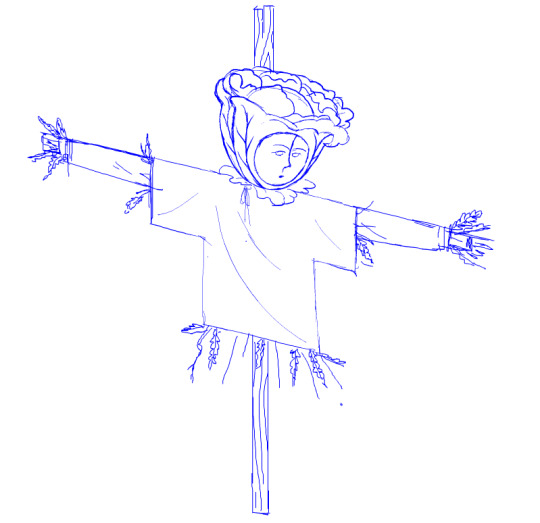
I'll then do a mix of hand drawing and vector shape tool rendering. I use the Paint Brush tool to hand draw strokes, and the line and shape tools mixed with transform to make more geometrically accurate shapes. The design is rendered into divided closed loop shapes, ready to be filled with a solid. The strokes are kept or removed depending on the design.
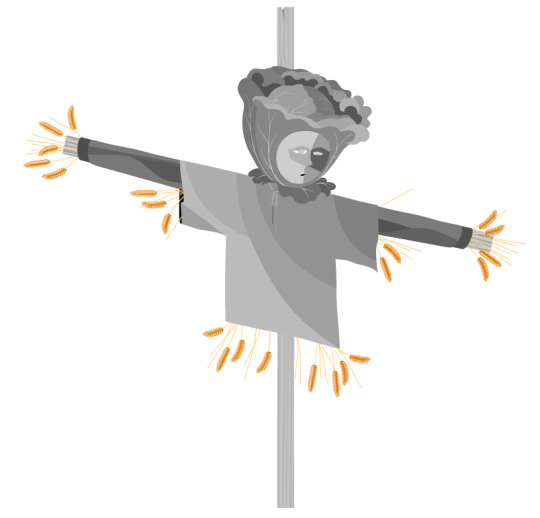
These fill shapes are then either coloured and rendered in Adobe Animate, using fills, gradients, or a more complex process of masks and effects.

Alternatively, I'll bring all these vector shapes into Photoshop and use them as clipping masks. The vector shapes act like masking taped areas or shields to maintain sharp edges, while the brush is like an atomized airbrush used to build soft volumed forms.

Please excuse all that horrible Adobe Cloud and AI bloatware...
And there we go!
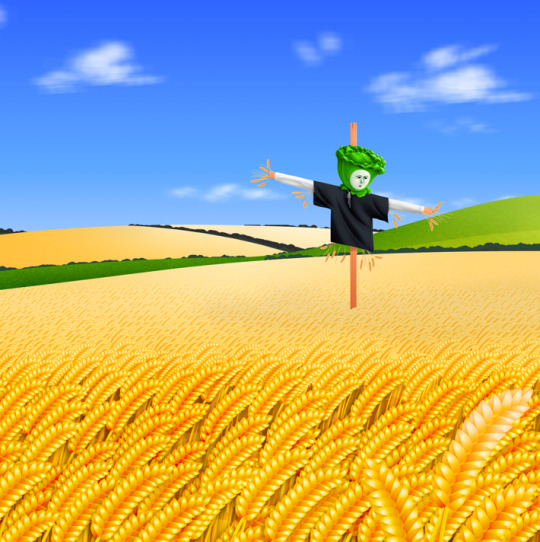
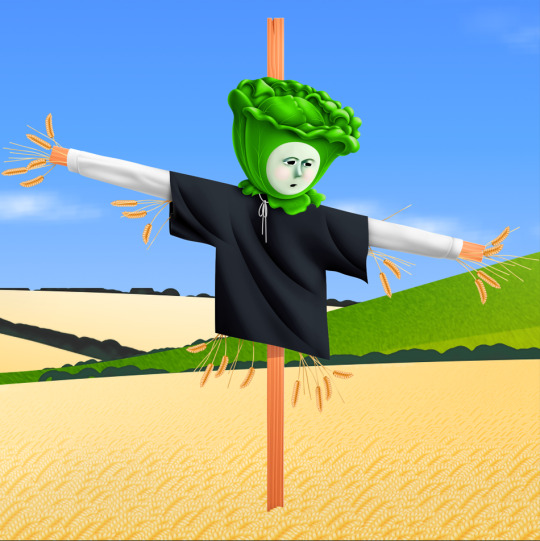
Variations in the process include just using MS Paint, index color in Photoshop, or 3D programs.
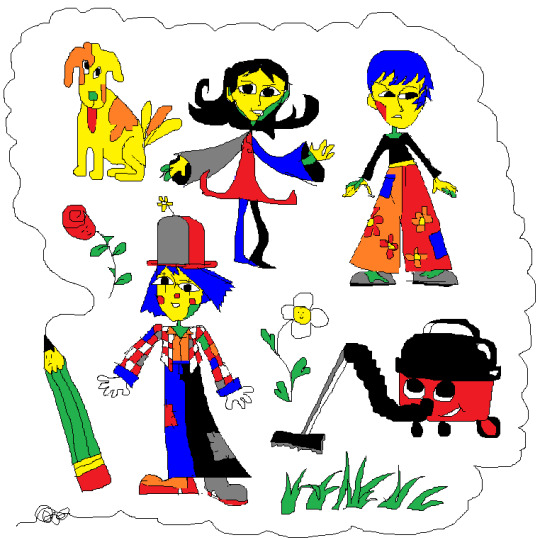
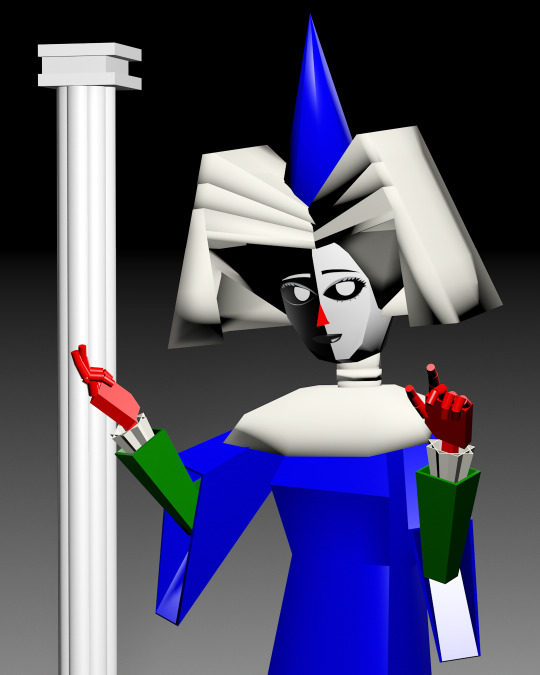
Very old works of mine were almost abstract, just exploring digital mark-making, which was a trend I was following in the mid 2010s that I loved. This kind of stuff.
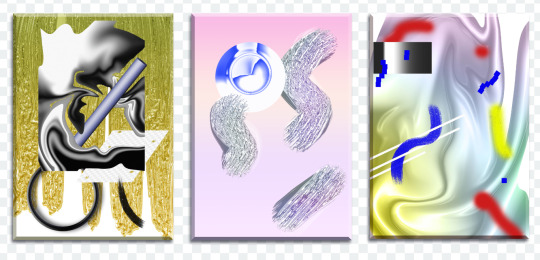
While my current work uses its digital material specificity as an intermediary to the subject in the illustration.
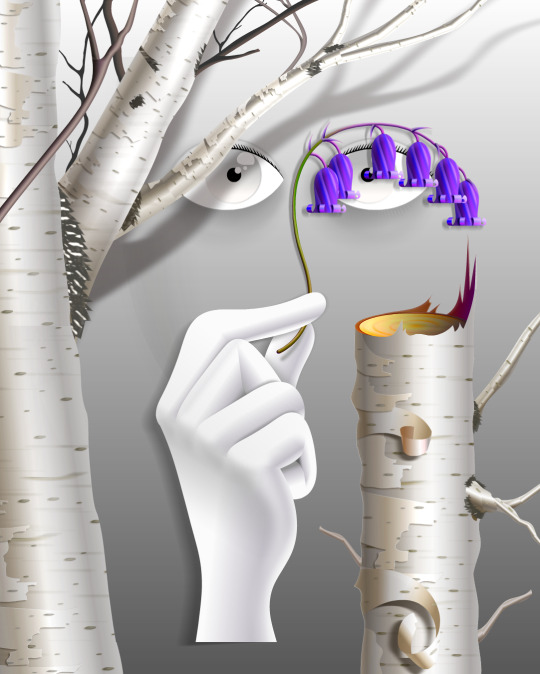
For example, #ersatz.world parodies clip-art and flash edutainment styles but imagines the characters living within that kind of world. The designs are meant to be cute, easy to read, light in computer processing, but also irreverent, janky, and generic too.
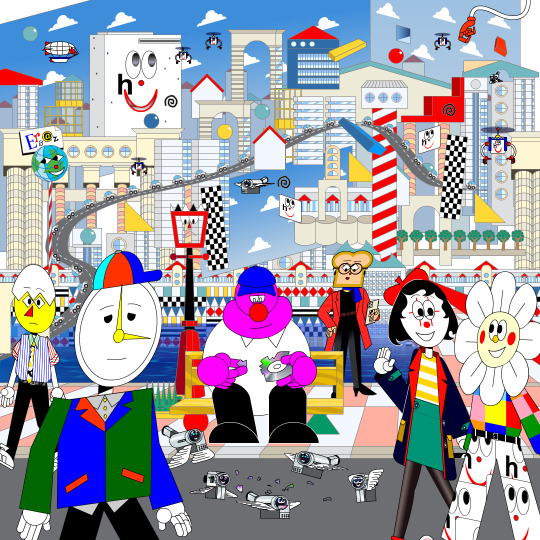
People typically regard this sort of clip art style as ephemeral trash, but I always found them charming. I use Ersatz World primarily as a satire vehicle, parodying educational formats to spoof corporate explainer content and digital media.
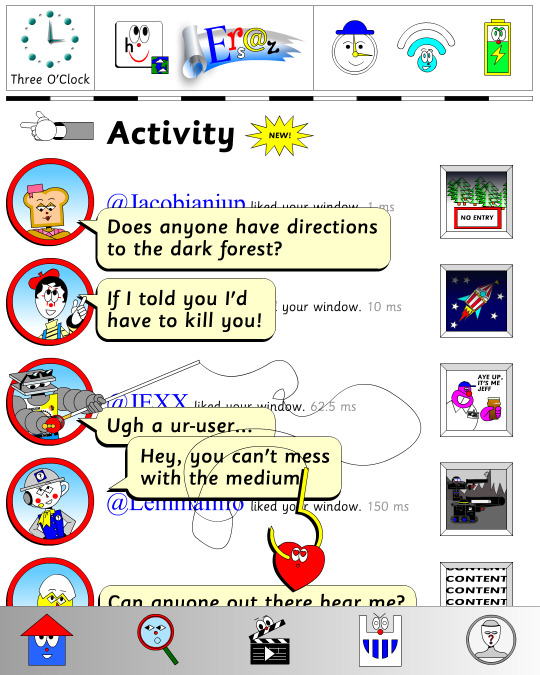
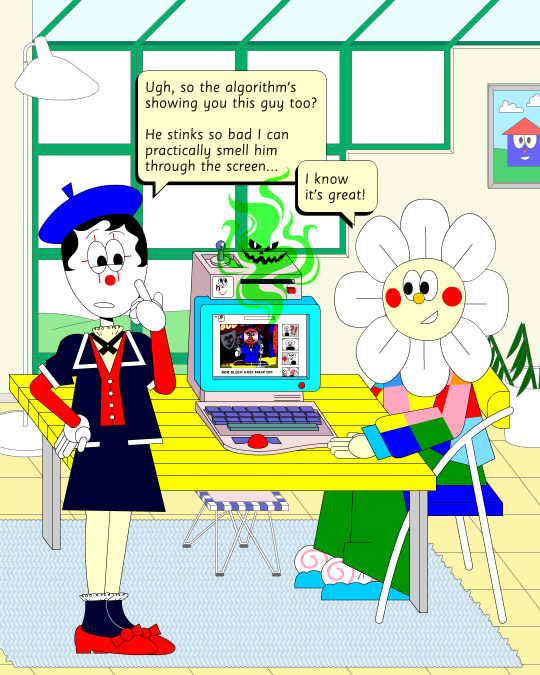
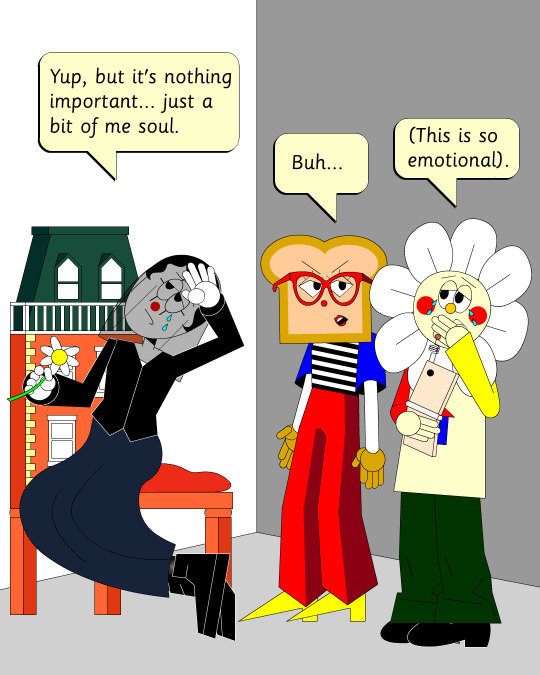
However, part of the problem with Ersatz is I've made it look too polished, complex, and I've grown too attached to the characters, which I imagine is a typical issue with overbuilding a world. So recently, I've made an even jankier Ersatz-like set of characters to play about with, using an even simpler style with less cohesion. I like to try and use slightly different styles and digital material styles to relate to the property at hand.
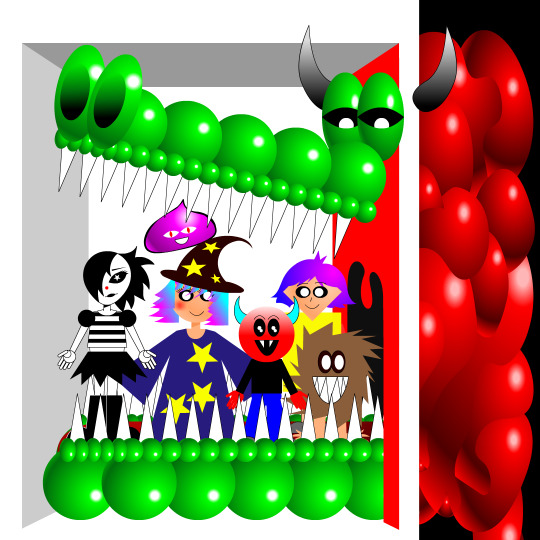
That’s why #autonymus has a bitmap digital material and a denser feel to it. Unlike Ersatz, Autonymus is not meant to be an overt semi-meta fiction. It’s not exactly pixel art, but the pixels are just about visible, as the intention is to create a digital expressionist depth to the setting. Although it’s still stylized and not realistic to our world, I definitely still want to evoke semblances of our world. That’s why there’s attention to landscape, plant life, and implied life beyond what you see in the frame with the characters, etc. But I'm still making a cartoon, and I still want it to feel at ease with itself being a digital material work. Characters are therefore flat, simple, stiff, and the speech style is like a bad Shakespeare parody. I like to balance between ugly and appealing, simple and complex, familiar and unfamiliar.
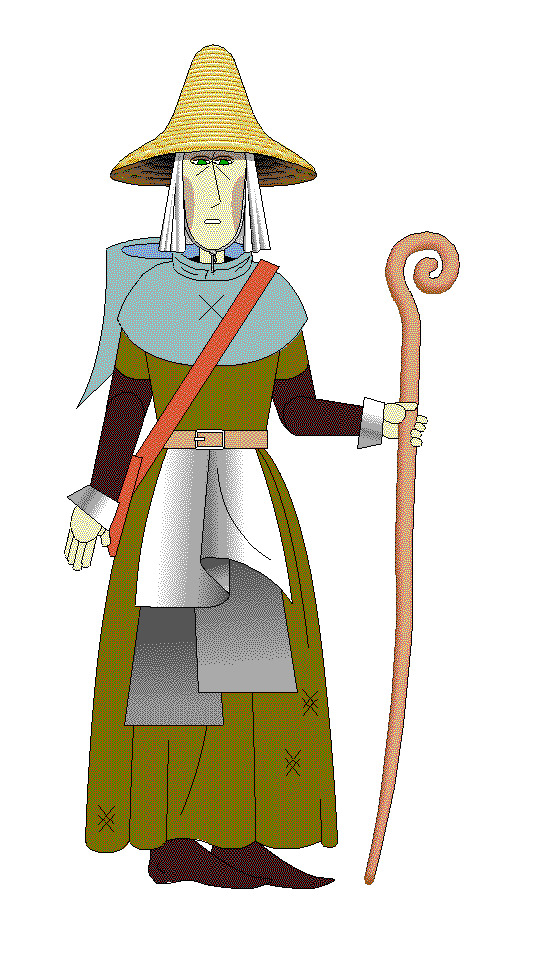
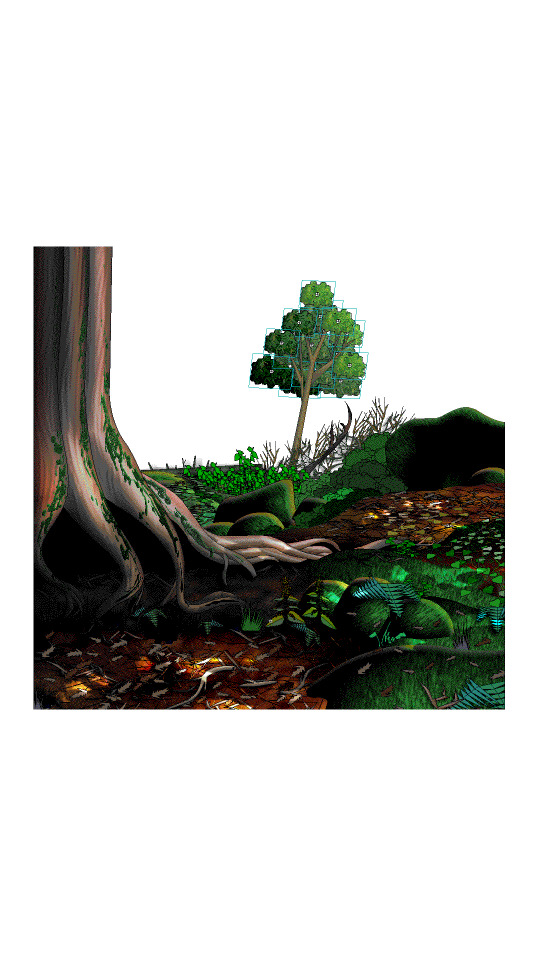
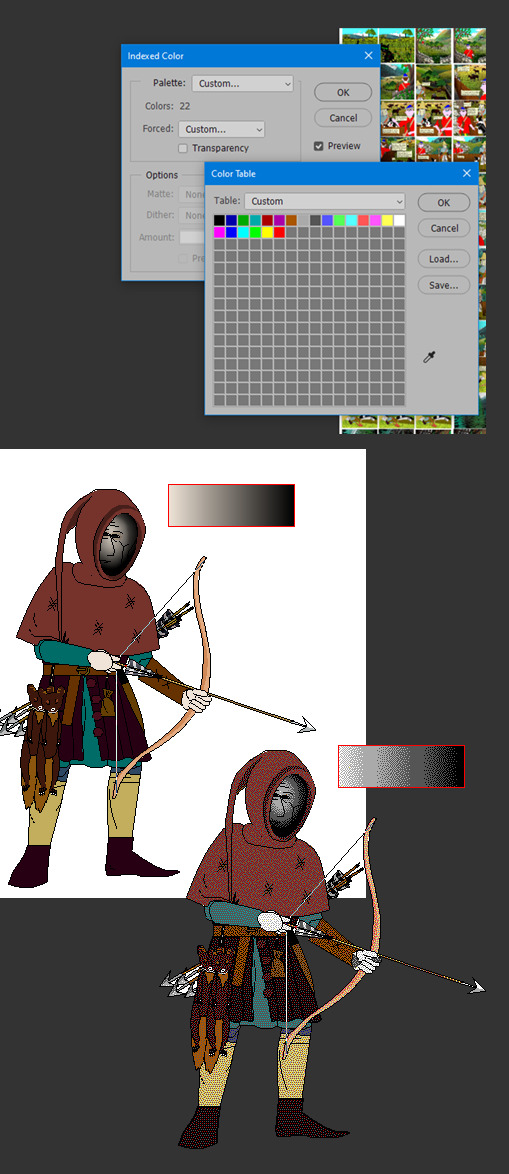
In regard to things like inspiration, references, and my relationship to aesthetic genres; these things certainly factor into my work, perhaps I'm even overtly dependent on them. My work can definitely be post-modernist in method; creating new, ironic, or fragmented interpretations through deconstructing a mix of various styles or methods. But at the same time, I'm still trying to make a digital gestural representation where the aesthetic is driven by my relationship to the software and techniques directly—not simply in an attempt to reference a style. For example, I like drawing lines in sweeping strokes, not to a point of geometric perfection, but just in a way where the curves are smooth and simple. But if I want perfectly curved or straight lines, I'll use the vector tools.
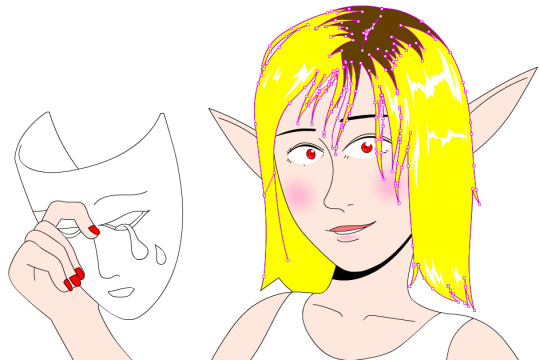
Working this way, you can sort of learn why certain styles and design choices in past vector aesthetics were made, as they would have also needed to make similar choices. That’s why I’m more mindful of using digital material specificity as a foundation to build narrative and subjects upon these days.
For example, genre references like cyberpunk clichés for #cyberhell or late medieval design for #autonymus or 2005 to 2015 era subculture fashion for #gradientgoblinz.
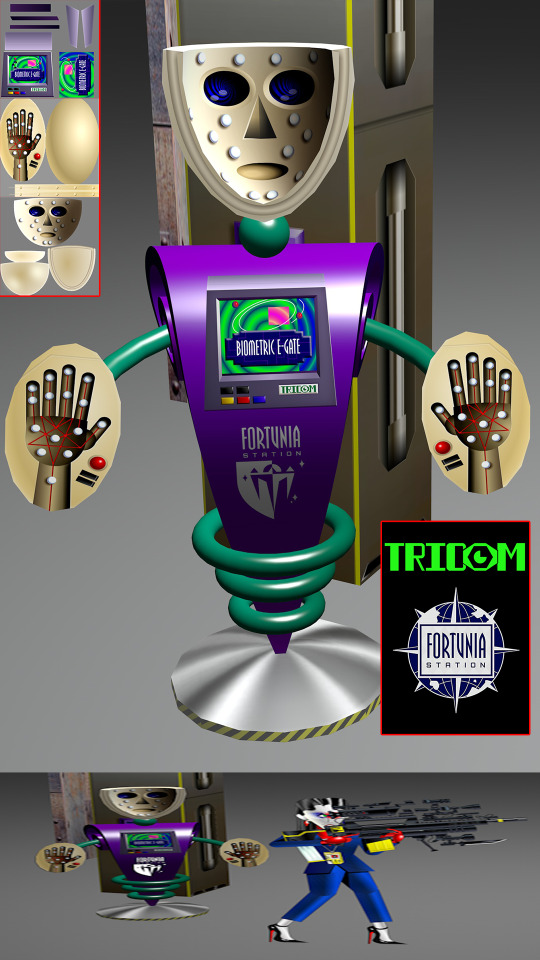
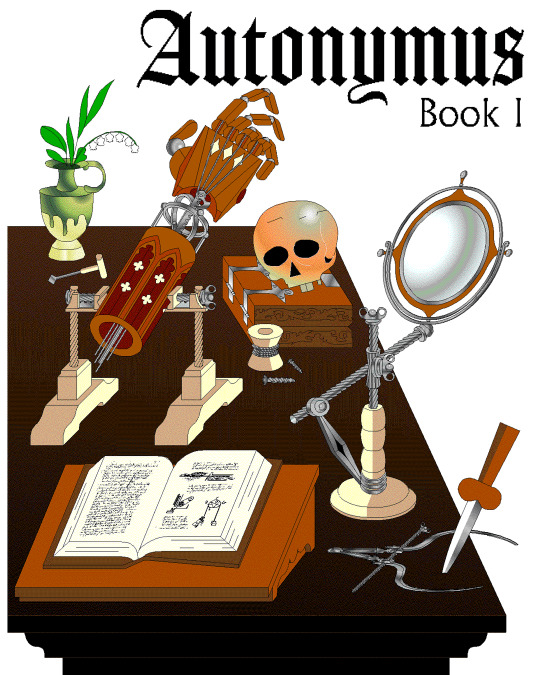
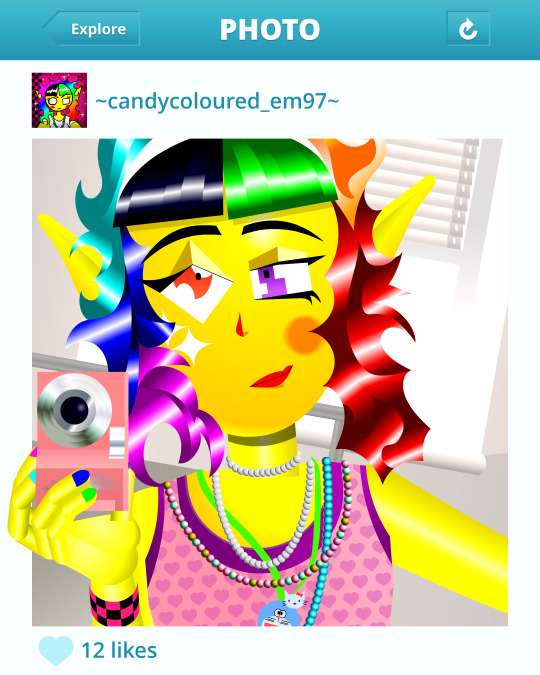
I think it’s important to take inspiration and reference from a wide variety of sources, but I think they’d mean nothing without having something to say or express. Autonymus, although it is a collection of tropes and clichés, isn’t just about that. It’s a story about the tensions of socially constructed systems and how that shapes faith, technology, and the natural world, or at least that's what I'm aiming for anyway.
But despite all that, I think there’s a danger of locking myself into the past by using these methods. For example, using nostalgia and references to past aesthetics can result in just recreating the past in a form of role-play. To avoid that, I try and evoke the past through a messy, inaccurate pastiche rather than caring to accurately re-enact anything. I’m probably not always successful at communicating the deliberateness of this, and it can certainly get very frustrating and pedantic. To be honest, I do kind of hate aesthetic labels (terms like Y2K, global coffee house, utopian scholastic designs from a pre-9/11 world).
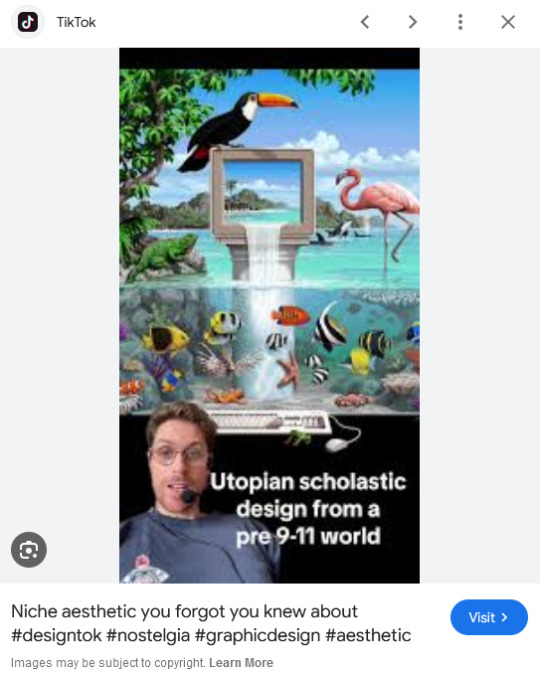
I do not believe that a project aimed solely at mapping history through aesthetic styles is worthwhile. Sure, they can be handy for organizing style trends, but they can also be reductive and ahistoric. Who are these people to define the history of these design eras? The result is a kind of suffocating simulation of design history but removed from context, perfect for moodboardism. I wish it felt more tongue-in-cheek, less absolute of itself in its own practice. Instead, it acts to legitimize and engender those making these labels, almost giving them ownership of the design styles. It’s similar to the logic and process of generative AI and its databases in a way, just done manually.
I’m very inspired by artists like Oneohtrix Point Never in this regard, as I think he’s able to create an aesthetic portal to all kinds of memories, feelings, and worlds reminiscent of the past, while still being in the present. It’s more a reflection of how timelines are messy now, like a memory or dream, rather than an audacity to say the past was actually like that, or to try to actually map some kind of timeline.
I think the benefit of this process is how it avoids the other side of the spectrum—being locked into chasing the cutting edge of digital processes. I don't necessarily think using an old digital process means your work inherits the semiotics of old aesthetics. Non-digital mediums don’t have this issue to this degree, as you can still paint in oils and be considered contemporary, or at least it's not frowned upon to such a degree. And I also don't think anyone in the heyday of Flash ever made work the same as I do, especially as computers are more powerful now so can handle more. I probably shouldn't boast too much about that though, as artists at the time probably just had more sense than to use Flash like a painting program! So then, why is my use of Adobe Animate critiqued as obsolete and an aesthetic dead-end? Because to whose standards is this process obsolete? If you value digital aesthetics as an apparatus in industry practice, then sure, my work is redundant.

But as wonderful as the latest tech can be in creating new aesthetics, I do feel it can be overtly dependent on the trends and directions of tech corporations, and therefore act as an indirect propaganda tool to their hegemony over digital aesthetics, such as the ever-demanding processing power needed for simulated realism. If anything, work that does follow in the direction of the latest tech trends is ironically the quickest to date once the trends move on.

I've noticed I've not really described what my work is about, just the process, in this text. But I don't know, maybe I like Flash because it is regarded as redundant. No one really cares about it, so I feel free to make whatever I want, and can decide on form myself, to my own standards, the quality of my work. As fun as making images is, I find it difficult to put into words what it is exactly I'm expressing in my work, and perhaps that would spoil it anyway.
221 notes
·
View notes
Text
Also preserved in our archive
Y'all know I'm not one to save celebrity news without reason: There's some excellent analysis done in this article about air quality and airborne disease.
Macbeth: cancelled due to “illness” The eagerly anticipated production of Macbeth, starring David Tennant in the title role at the Harold Pinter Theatre, has cancelled four consecutive performances this week due to “illness within the company.” The latest cancellation, announced just two hours before curtain, left audience members disappointed, including those who had traveled internationally and rearranged work schedules.
Among affected ticket holders, some expressed frustration on social media about the late notice and lack of clarity. Twitter user @clairebobcat voiced a common sentiment:
"Ticket holders were notified at 5:45 this eve. Really short notice considering illness has been ongoing since Friday. All best wishes to the cast���illness can’t be helped, but very shoddy treatment of ticket holders. Travel money & Annual leave wasted."
The ongoing cancellations reflect broader challenges facing the theatre industry in the ongoing Covid-19 pandemic.
The arts still in crisis due to Covid A survey by Theatre Washington reported that while 58% of Washington, D.C. theatre patrons once attended performances six or more times per year, only 31% have done so since reopening. Almost half of patrons surveyed now attend just three times or fewer, and nearly 68% cited fear of Covid-19 exposure as a primary reason for staying away.
The UK is facing unprecedented rates of long-term illness due to long Covid, a condition marked by symptoms including post-exertional malaise, cognitive impairment, and cardiopulmonary dysfunction.
Public health data shows that over two million people in the UK are affected by long COVID, with more than 10% of Covid cases resulting in prolonged symptoms.
High-profile performers, including Alyssa Milano and Matt McGorry, have spoken publicly about their struggles with long Covid, shedding light on the profound and lasting impact of the illness.
Protect the Heart of the Arts In response to these issues, Protect the Heart of the Arts, an advocacy organisation for members of the performance community with long COVID or who are clinically vulnerable, has offered to donate a HEPA air purification system to the Harold Pinter Theatre, which is staging Macbeth.
Glenda from the group told the Canary:
"It’s unsustainable, unethical, and we can’t afford to accept it as occupational: our employers, unions, regulatory bodies and politicians have to address the ongoing SARS-CoV-2 pandemic head-on.
Beyond key vectors (hospitals, schools, prisons), creatives are uniquely vulnerable, especially within live formats, alongside venue staff and audiences; not to mention all within said categories who’ve been marginalised, nor the walk-back of digital programming."
The organisation argues that improved air quality could help reduce health risks for cast, crew, and audiences, potentially preventing further cancellations.
Covid isn’t over – as Macbeth inadvertently shows “We may not know the exact illness affecting the Macbeth cast, but we do know that Covid is a serious vascular disease requiring extended recovery times,” noted Charles Waltz, founder of Protect the Heart of the Arts:
"Reinfections weaken immunity to other pathogens, so without measures like air purification and adequate recovery time, we risk ongoing illness cycles that could impact health and stability across the industry. Clean air and flexible recovery policies are essential to protect the performance community’s long-term health."
#mask up#covid#pandemic#public health#wear a mask#covid 19#wear a respirator#still coviding#coronavirus#sars cov 2#stage play#stage management#theatre#covidー19#covid conscious#covid is airborne#covid pandemic#covid isn't over#covid19#covid news#clean air
123 notes
·
View notes
Text
I actually find the topic of "Nomura's evolving art style as he takes on more and more responsibility at Square (and subsequently has less time to Do Stuff)" really fascinating.
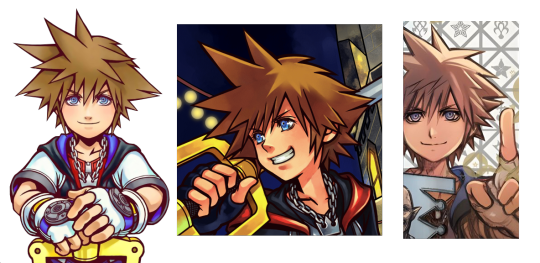
Like, If you compare his art from the KH1-DDD era to his current day art, I think there's a noticable difference to his approach: how many steps there are in his art process, how he chooses to finish a piece, and the shift from a clean digital style to a more organic traditional one.
He used to use very clean, black lineart; bold colors; and more instances of defined/hard shading for that digital, almost cell-shaded or vector kinda look. Nowadays he goes for a more sketchy + watercolor style with pencil lineart, broad washes of faded color, and color shading that's a bit more blended and simplified in places (relying more on the pencil shading to create distinct shadows), with the hard edges more often reserved for scattered, bright highlights. (He's made art like this in the past eras too, such as the KH main menu arts which all have a watercolor quality to them, but the lineart was a bit more defined then and less sketchy, and thus slightly different from his current stuff.)
I think the Dark Road key art is a very good example of his current art style. The sketchy, almost brown lineart. The watercolor quality that emerges where two colors meet and overlap. A little desaturated and earthy. Color shading that's very broad, soft, and loose, with sharp highlights here and there.

Both styles have their merits (I personally love this sketchy era of his), but I think it's pretty likely that he adopted this as his "main" art style in order to adapt to time crunch. He doesn't need to do time-consuming lineart and precise shading anymore; he can use the original sketch as the lineart instead. Heck, he can fill in a bunch of the shading via pencil during this sketching phase to save even more time, and then can paint in a more watercolor-y kind of way that allows him to color in quicker, broader strokes.
And then there's the occasional art mistake that has become a bit more frequent in recent years, by my estimation. Which I imagine, again, is due to running out of time to notice/fix those mistakes. Things like Ephemer's arms being a bit too long in this UX art, the Kingdom Key being slightly off-model in this anniversary art, or the ears on this Mickey Mouse symbol being two different sizes on this Utada album art.


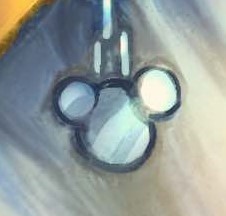
(Which isn't to say that he hasn't made art mistakes in the previous eras, for example he initially got the colors of Riku's shirt mixed up in the Re:CoM cover art before fixing it, but I still think the mistakes were a bit less frequent back then.)
And like, hey. I draw, too. Amatuerishly, but I do. I don't blame Nomura for possibly needing to change his approach to making art in order to meet deadlines, nor do I blame him for these little art mistakes that ended up falling through the cracks. I imagine he simply doesn't have the time anymore now that his job has shifted from (primarily) being a character designer/illustrator to (primarily) being a director of multiple, simultaneous projects. Or maybe I'm totally wrong about this and his art evolution had nothing to do with time crunch, who knows. I think his current art style is gorgeous either way!
Anyway, I just think this is an interesting example of someone taking their art and adapting it to a difficult and highly limiting situation, experimenting with new things and finding the means to still make art even when you have less time to do. Also a great example that professionals are human and will make mistakes even in professional products, and it's not the end of the world, it just happens. If you ever obsess over a mistake in your art...maybe take solace in knowing that it happens to everyone. Even people who have been in their field for a very long time.
98 notes
·
View notes
Text
everyone suggesting alternatives for Photoshop is inevitably not actually using most of the Photoshop functionality, which to be fair is probably the vast majority of the potential Photoshop userbase.
the reason Photoshop has been industry standard for 30 years is that it does almost everything and has almost always done almost everything. it has had a few weird slow adoptions, for example it didn't support basic live mirroring while drawing until the 2010s (ish). it didn't have recovery saves or auto saving until about then. it's never been the absolute last word in real media synthesis, that was Corel Painter for years and now I think CSP is probably the king. illustrator is better at vectors. etc. but Photoshop can do all of those things well enough to prepare a professional grade, print-ready artwork from RAW file to layout to text to retouching to total from-scratch illustration, in one step, with layer and channel separation, multiple types of masking, adjustment layers, lossless file object placement, vector text transformation including all standard print layout tools like kerning, like spacing, comprehensive font support, and both true font variation and faux transformation like fake bold and fake italic. and clients and print workflows are expecting PSD files and file preparation for this reason. Krita, as an example of a popular program suggested as an "alternative to Photoshop" which I have used for hundreds of hours to do professional and personal work, is great for drawing but has a completely unusable text engine, you can't make a webcomic with speech bubbles easily and quickly in Krita. it was like pulling teeth even trying to put "BABY SLUT" on my Lethal Company skin with Krita. but you can lay out an entire magazine in Photoshop in an afternoon, and people do (print preparation is whole other topic I'm not saying vogue is prepared solely in Photoshop, it isn't, I'm saying you CAN do it in Photoshop)
I have never paid for an Adobe product, I am not pro Photoshop, I am pro getting my work done. I would absolutely love for there to be an actual Photoshop alternative, but there isn't. there are individual alternatives for individual features of Photoshop, and if you are working in a limited professional scope or you just want a drawing program or just want to make your webcomic or just want to do pixel art then one or two programs will replace Photoshop for you. everyone who, like me, has to do RAW editing, fashion retouching, print and web layout, pure digital illustration, vector illustration, text and graphic design, and all the rest of the crap I have to do in a format that's accepted by publishers and the rest of the various workflow destinations it's just not realistic. which is why it's great that Photoshop is completely trivial to pirate at any stage of its development you care to install,including versions prior to the introduction of the AI crap, the cloud crap, and the rest of the crap no one serious is actually using unless their manager is forcing them to
135 notes
·
View notes
Text
pre-calc with lilac!
today we're learning some stuff because i have learned it and i need to teach someone
vocab:
vector- a line that has both magnitude (distance/speed) and direction; shown as an ordered pair or ordered triple
scalar- a line with magnitude but not direction; a singular number
dot product- multiplying two vectors together; this gets you a scalar
cross product- multiplying two vectors together; this gets you a vector; only for three-dimensional space
orthogonal- when the dot product equals zero
dot products are shown as (a • b) and cross products are shown as (a x b). we use <> as parentheses instead of ().
right now we're going to talk about dot products. so if i have the coordinates <3,4> and <2,2>, we multiply the first number in both of them and then the second number in both of them. so 3x2 is 6 and 4x2 is 8. now we add these to get 14, which is our scalar value and the dot product of the two vectors.
now you try. < 3, 6 > • < -4, 2 > you should get the answer 0. and what does it mean when the dot product is zero? the vectors are… orthogonal!
any questions? the next lesson will be about cross products, but that's a little much for today because i also don't know how to format it in tumblr!
thank you for your time
24 notes
·
View notes
Note
Dear, Vector Prime.
Are there other Transformers that transform into deer besides Scrapper? I would like to know the female ones if possible.
Dear Antler Appreciator,
The Scrapper you mention is far from the only one. Some non-Hybridizer incarnations of Thunderhoof turn into deer. The Autobot Herne, when outside of his Pretender shell, transformed into an electro-elk—as did Sero, a Maximal Resistance member who underwent the Beast Upgrade. Now that you mention it, it’s curious that of all the individuals who come to mind, from across the multiverse, not one of them is female. I wonder if there is some underlying metaphysical principle that precludes the adoption of the doe as an alternate form…
This reminds me of a story, which—if my chronometer is to be trusted—should be seasonally-appropriate. Gather around the energon furnace, and I will tell you of the time Sky-Byte learned the meaning of Christmas.
Between schemes, Sky-Byte’s personal mission to understand human literature was well underway. Having already enjoyed A Tale of Two Cities, he next set his sights on that seminal classic, A Christmas Carol. So moved by it was he, that Sky-Byte was inspired to spread the “Christmas Spirit” to his fellow Predacons—and thus he enlisted the help of Slapper, Gas Skunk and Dark Scream, to play the role of the three spirits in his own re-enactment… and as for the miserly Ebenezer Scrooge, why, that part would be played by none other than Megatron, of course.
The production went about as well as you might expect. Nevertheless, having been alerted to the magical properties of the “Christmas Spirit”, Megatron couldn’t help but covet this power for himself. He turned once more to Doctor Onishi’s memories, and in doing so, learned of the existence of the being known as “Santa Claus”.
Megatron reasoned that Santa Claus was the being who commanded the Christmas Spirit, and plotted to hijack the holiday. That night, he travelled to the North Pole to lie in wait… and when the sleigh appeared, he used his flying hand mode to snatch Santa Claus and all the presents! Having stolen Santa's list, he checked it twice, identifying the nicest humans with the most Christmas Spirit to take. On the back of the sleigh, he mounted the Predacons’ psycho-probe, which had been modified to absorb this psychic energy, stealing the hopes and dreams of children asleep in their beds. Dragging it behind him, Megatron changed into his reindeer mode… and took flight.
On Christmas morning, the Autobots were surprised to find a miserable Koji Onishi, who didn't even want to get out of bed to open the Autobots’ gifts. Their attempts to cheer him up only irritated him further. X-Brawn wondered if Koji was upset to be spending Christmas without his father, but Side Burn couldn’t shake the feeling that something was wrong…
Meanwhile, at the Megastar, Sky-Byte had been left to guard Santa Claus—as Predacon intelligence suggested the old man had a preternatural ability to break in and out of buildings unnoticed. But when Santa Claus revealed to Sky-Byte that his name was near the very top of the naughty list, the Predacon shark had a crisis of conscience. He sent out a transmission, which was received by T-AI at Autobot HQ, to warn them of Megatron's scheme.
Unfortunately, the number of humans affected by the psycho-probe was rapidly snowballing, causing a wave of humbuggery that would give even old Scrooge himself pause. Combined with Santa's magical sleigh, Megatron was moving faster than the Autobots could possibly keep up with! Only Rail Racer stood a chance of catching him, but Team Bullet Train was off-duty, as trains don’t run on Christmas Day. Thinking quickly, the Build Team modified the Global Space Bridge to lock onto Megatron and trap him in the transwarp field, allowing Prime and the Autobot Brothers to intercept. Cornered, Megatron needed more power if he was going to stand a chance—and unfortunately for the Autobots, the Christmas Spirit had unlimited power to give. Absorbing the stolen energy into himself, he supercharged his body into a menacingly festive new form, decked out all in red and gold. The victory he had chased for so long was finally within reach. The Autobots always got what they wanted. Why shouldn’t he?
Koji shouted to Megatron that he would never understand the meaning of Christmas. After all, it’s not about getting what you want—it’s about giving to others. But Megatron only let out a wickedly jolly laugh, for he did indeed have something for the Autobots… and with that, he began to charge his devastating Cutter Beam. Koji begged for him to listen. All the young boy wanted was to spend Christmas with friends and family—to see his father again, to have just one day without fighting. Why should such a dream be impossible? If only he promised to stop fighting, even Megatron would be welcome at their table.
And though Megatron laughed, some part of this warm sentiment touched his icy spark. It triggered a chain reaction in the Christmas Spirit coursing through his circuitry, which fought with his natural evil impulses… before finally exploding. Free once more, the Christmas Spirit returned to all the good little girls and boys. Bitterly, Megatron asked Koji if he had truly meant it. But before the boy could respond, Megatron saw a rift in the transwarp, and took his chance to retreat. Optimus Prime thanked Koji, and renewed his promise to rescue Doctor Onishi—though he regretted that they had not stopped Megatron sooner, and that all the children would be waking up without presents…
When Megatron arrived back at the Megastar, he was furious to discover that Santa Claus had vanished—and Sky-Byte, too! Meanwhile, all over the world, children found gifts had mysteriously arrived under their trees. A little girl looked out of her window, and caught a glimpse of a bearded man in a big red sleigh… pulled by a flying shark.
Merry Christmas, everyone.
#ask vector prime#transformers#maccadam#robots in disguise 2001#sky-byte#scrapper#hybridizers#thunderhoof#herne#sero#beast wars uprising#beast upgrade#megatron#optimus prime#prowl#side burn#x-brawn#slapper#gas skunk#dark sceam#t-ai#santa claus#christmas#koji onishi#doctor onishi#global space bridge#rail racer#landfill
39 notes
·
View notes
Text
my proposition for making doctor who ship names Way Worse:
in order to find each doctors ship name you need to convert their respective numbers into radians for their respective angles on the unit circle and then add the angles together. the resulting ship name is the vector product of the two vectors making the angles from the x axis. Inbetween doctors will usually have decimal numbers (10.5 for the metacrisis doctor, 11.5 for the ganger doctor, etc)
when shipping a character without a numerical name, convert each letter in their "common" name (so usually just first names) to its place in the alphabet and add them together, and then convert to radians
additionally when converting to radians, you must use pi at the same number of decimal places as the doctors number. no rounding.
214 notes
·
View notes
Text
Design for liege maximo and g2 cybertronian troopers
they're the product of a failed experiment on ancient cybertron to raise soldiers inside a pocket dimension where every factor could be controlled from the outside. They escaped their dimension but their tethering to our world is tenuous at best


The functionist council didn't hold power over cybertron exclusively via the military, they also controlled the super computer vector sigma that monitored and regulated cybertron's systems, said to be able to see the future , explaining the transformer's humanoid shape.
The transformers were already creatures built rather than born but the government wanted more control over what kind of people made up their citizenship. And used vector sigma to simulate another world, they called it their g2 universe, later it would become the dead universe and later still. A fire dimension
Liege maximo was the leader of quintessa in this world, and in that reality, Cybertron developed into a galaxy spanning empire until it grew so big it began to rub against the walls of the simulation, as the leader if a "lesser" colony world, liege maximo was sent out to inspect the anomaly alongside his two liege centuro soldiers and as they pushed out into the walls of his universe they began to physically emerge out of vector sigma.
In panic the technicians shut down the simulation as liege maximo emerged which caused him and his soldiers to be torn between dimensions, becoming incorporeal in places like a ghost
The g2 experiment was deemed a failure and not wanting to waste a potential resource liege maximo was assigned a job based on his original alt mode, a military commander, but he grew bitter at the destruction of his home,
frustrated by the small size of cybertron's dominion in this reality. He secretly supported the revolution brewing under prima's leadership in the hopes of fetching power once the current society collapsed so he could turn cybertron into a galactic dreadnaught and conquer our world's version of quintessa, for sentimentaliy's sake and then regrow the cybertronian empire of his world
but the other leaders of the revolution didn't know that, and accepted him among their ranks like they would do to any other supporter for their cause, but liege maximo's true intentions would come to light upon the successful dismantling of the functionist council. And those loyal to him and his pupil megatronus became the first decepticons while those loyal to prima and her mentor alpha trion became the first autobots
#transformers#transformers fanart#cybertronian#robot#robots#character design#maccadam#decepticons#maccadams#tradionalart#traditional drawing#transformers au#transformers g2#transformers from a to z#liege maximo#autobots
33 notes
·
View notes
Text
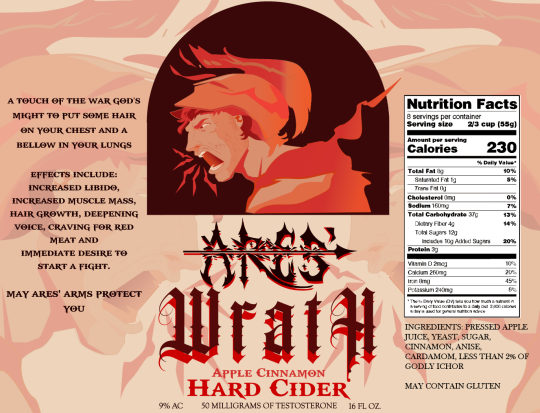
Another digital media project, this time a more fun one. We had to come up with a product that had a gimmick, and I thought it would be funny as hell to make a hard cider that also doubled as a T-shot, courtesy of Ares. I had plans to do two more, a honey and sage flavored Mead from Tyr, and a pomegranate and hickory beer from Mars.
I may still go back and vectorize those sketches, I think having the full set would be really funny. Also I really love how this turned out, so I'd feel really good about finishing out that set.
#vector art#graphic design#graphic illustration#ares greek god#ares god of war#greek mythology#greek myth art#product design
15 notes
·
View notes
Text
Reading Week Study Plan 4th-10th of November {For those that do not study in the UK, reading week is basically a week in the middle of the semester without any lectures, dedicated for students to revise previous content from the last weeks of classes and to relax from constant lectures and seminars!} Here is a general list of what I will be doing (crossed = done):
Vector Calculus:
Re-do all weekly tests Re-do all exercise sheets Re-do all assignments Finish all Springer exercises
Optics:
Re-do all assignments Re-do all exercise chapters Revise all notes and problem classes
Quantum Mechanics:
Re-do all exercises Re-do all assignments Revise all material and assigned reading
Thermodynamics:
Re-do all assignments Re-do all assigned exercises Revise all material Make notes of lectures playlist
Philosophy of Science:
Finished all of Kuhn's readings Finished all of Popper's readings Start planning and structuring arguments
Additional work:
Finish occupational report and CV analysis Finish scientific computation report Finish Data Ethics Frameworks project
{My aim is to at least partially check this entire list. I have spent the last two days working solely on reports and projects and have deprived the revision of my module s' materials and preparation for exams. I wish all of those studying in the UK, a relaxing and productive reading week!}
#study#studyblr#studyspo#studyspiration#study hard#study blog#study motivation#study inspiration#study aesthetic#reading week#uni#university#dark academia#academia aesthetic#classic academia#stem academia#chaotic academia#books and reading#books
26 notes
·
View notes
Text
Also preserved in our archive
Won't someone think of the egg prices!
By John Lindt
KERN COUNTY – The price of eggs is often used as a barometer for the economy, but this fall’s high prices are not the work of market factors, but rather migratory flights.
Avian flu is spreading along the path of birds’ southern migration for winter across California. As of Nov. 12, the U.S. Department of Agriculture (USDA) reported that a large egg ranch in Kern County has been impacted by bird flu resulting in the destruction of 2.15 million egg layers. This is the first case of HPAI in Kern County during the 2022-24 bird flu outbreak as it spread south heading into winter. Kern County is home to some of the state’s largest egg ranch operations.
The same day USDA also announced that avian flu hit two Fresno County poultry ranches, one a broiler ranch resulting in the killing of 237,700 chickens being prepped for meat and a turkey ranch requiring the destruction of 34,800 toms, or male turkeys. The news follows recent reports about avian flu spreading to Kings County poultry ranches resulting in the loss of over half a million birds and at another Fresno ranch. On Nov. 14, USDA added three more poultry ranches to the list of affected including one in Merced County, a turkey ranch with the loss of 53,200 birds and another one in Fresno County.
The locations of the poultry ranches are not far from the Pacific flyway, a major migratory route in the Western United States. In the case of Kern County, the egg ranch was close to the Kern Wildlife Refuge as well as nearby dairies. This is worrying observers that there appears to be a connection between all three vectors for the rapidly mutating virus.
Northern California poultry operations have been hard hit as well. Nationwide, outbreaks have claimed more than 21 million hens, so far in 2024.
Egg Prices In California the impact on egg prices has been significant.
On Nov. 13, the USDA reported that a dozen large, white cage-free eggs cost about $5.26 per dozen in California. This is according to USDA market data for the week of Nov. 8. USDA says this is a “benchmark” price. The price is up from $2.81 a month earlier. That is almost double the benchmark, but may not reflect retail.
The last time California eggs were this high was in February when California egg prices – cage-free egg prices – peaked at $5.59 per dozen.
The cases of infected birds correspond with fall bird migrations that are spreading the virus throughout the state. Detections are higher in fall and spring as wild birds spread the virus when they migrate. This year the bird flu has taken its toll with the outbreak of H5N1, a highly transmissible and fatal strain of avian influenza, or bird flu. The outbreak started in early 2022 and rapidly grew into the largest bird flu outbreak in U.S. history.
Most recently, outbreaks affecting more than 2.84 million egg layers were reported in October at commercial facilities in Oregon, Washington and Utah, according to the Centers for Disease Control and Prevention (CDC).
As of Nov. 8, the virus has affected over 105.2 million birds in the U.S. since January 2022, according to the CDC. The California egg shortage will likely have a pocketbook impact on holiday baking activity as the nation prepares for Thanksgiving; however, a recent USDA analysis suggests consumers may not see a huge jump.
“Large volume grocery retailers across the nation have launched their shell egg feature campaigns targeting holiday demand at relatively attractive price levels. Much of this is attributable to changes in the way shell eggs are being marketed with an increasing share (estimated at over half of all shell egg volume sold at retail) tied to production cost agreements not prone to fluctuation common in formula trading.”
There are about 378.5 million egg-laying chickens in the US. As of last year, there were 9.4 billion broiler chickens and 218 million turkeys processed, according to the USDA. Advocates note the high cost of the influenza just in the egg market. “With domestic sales of shell eggs and products amounting to seven billion dozen, consumers paid an incremental $15 billion as a result of the prolonged and uncontrolled infection.”
While bird flu is impacting poultry farms, another strain of the virus has impacted Central Valley dairies as well, spreading quickly since September to 291 dairy farms as of press time. Unlike poultry, dairy cows typically survive the virus, although milk production is expected to be impacted.
Avian flu is a worldwide phenomenon. In the past two weeks, the first cases of highly pathogenic avian influenza (HPAI) of the fall season have been reported in Albania, Great Britain, Romania, and now regions of Germany and Ukraine.
Despite the increase in US egg prices this holiday season, turkey prices are down from last year when supply was also affected by bird flu. Across the country, a 15-pound turkey costs an average of $31.16 ($2.08 per pound) in 2024, compared with $35.40 ($2.36 per pound) in 2023. That price reduction represents a price decrease of 12% from last year to now,” a report said. The lower price comes even as a U.S. Department of Agriculture report showed turkey production dipped more than 6% compared to this time last year.
Hen and Hoof The spread of this strain of the virus appears to be affecting both the Central Valley poultry and dairy industries at the same time.
Just before Sept. 1 there were no reports of the virus in the Valley’s dairy industry. But as of Nov. 15, there are almost 300 diaries, mostly in Tulare and Kings Counties, impacted with new ones being added every day.
The Valley poultry industry has been on a similar viral timeline which coincides with the annual bird migration along the Pacific flyway that happens each fall. H5N1 largely infects wild birds, with waterfowl such as ducks and geese being the natural reservoirs for H5N1 viruses. Most H5N1 viruses are highly pathogenic avian influenza, meaning spillovers into other bird populations can lead to high mortality rates, including domesticated poultry.
A compounding factor for the spread of the virus is that both livestock are often on land located right next door or just down the road. The Central Valley is home for both industries with animals, transported in and out, and service vehicles going in and out of these large facilities every day.
The industry website Egg-News this week pointed out that research shows that the infections can be transmitted over a distance of up to a mile while attached to dust particles. Fall is harvest for a number of crops, including the nut industry, sending up plumes of dust in the Valley sky, at times associated with winds.
Egg-News points out that dairy cow-associated H5N1 viruses have jumped back into wild birds, and recent outbreaks in domestic poultry resembled H5N1 in dairy cows.
In an editorial Egg-News said “APHIS Needs a New Approach to Control HPAIr.” They recommend that USDA’s Animal and Plant Health Inspection Service (APHIS) adopt vaccination as a disease control strategy for bird flu, with promising results from clinical trials. In May 2023, the U.S. authorized the vaccination of California condors against a type of avian flu.
Also, the USDA has approved field trials to test vaccines that could prevent dairy cows from getting the H5N1 strain of bird flu. The USDA approved the first field trials for the vaccine in September 2024. The USDA’s Center of Veterinary Biologics (CVB) is overseeing the trials. At least 24 companies are working on the vaccine, including Zoetis and Merck Animal Health.
If vaccines can save the U.S. poultry and dairy industry over the next year, the industry may have to worry about who heads up the U.S. Department of Health and Human Services (HHS), the agency which authorizes vaccines for animals and humans. Nominee Robert F. Kennedy, Jr. has made it clear he is anti-vaccine but has yet to comment on the use of vaccines in agriculture if he is confirmed for the role.
34 notes
·
View notes